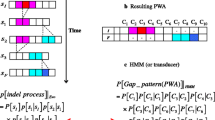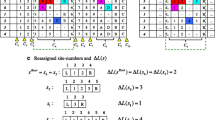Abstract
We develop here a new class of gene evolution models in which the nucleotide mutations are time dependent. These models allow to study nonlinear gene evolution by accelerating or decelerating the mutation rates at different evolutionary times. They generalize the previous ones which are based on constant mutation rates. The stochastic model developed in this class determines at some time t the occurrence probabilities of trinucleotides mutating according to 3 time dependent substitution parameters associated with the 3 trinucleotide sites. Therefore, it allows to simulate the evolution of the circular code recently observed in genes. By varying the class of function for the substitution parameters, 1 among 12 models retrieves after mutation the statistical properties of the observed circular code in the 3 frames of actual genes. In this model, the mutation rate in the 3rd trinucleotide site increases during gene evolution while the mutation rates in the 1st and 2nd sites decrease. This property agrees with the actual degeneracy of the genetic code. This approach can easily be generalized to study evolution of motifs of various lengths, e.g., dicodons, etc., with time dependent mutations.
Similar content being viewed by others
References
Akashi, H. and A. Eyre-Walker (1998). Translational selection and molecular evolution. Curr. Opin. Genet. Dev. 8, 688–693.
Arquès, D. G., J.-P. Fallot and C. J. Michel (1998). An evolutionary analytical model of a complementary circular code simulating the protein coding genes, the 5′ and 3′ regions. Bull. Math. Biol. 60, 163–194.
Arquès, D. G. and C. J. Michel (1996). A complementary circular code in the protein coding genes. J. Theor. Biol. 182, 45–58.
Béal, M.-P. (1993). Codage Symbolique, Paris: Masson.
Berg, O. G. and P. J. N. Silva (1997). Codon bias in Escherichia coli: the influence of codon context on mutation and selection. Nucleic Acids Res. 25, 1397–1404.
Berstel, J. and D. Perrin (1985). Theory of Codes, New York: Academic Press.
Campbell, A., J. Mrázek and S. Karlin (1999). Genomic signature comparisons among prokaryote, plasmid, and mitochondrial DNA. Proc. Natl. Acad. Sci. USA 96, 9184–9189.
Crick, F. H. C., J. S. Griffith and L. E. Orgel (1957). Codes without commas. Proc. Natl. Acad. Sci. USA 43, 416–421.
Ermolaeva, M. D. (2001). Synonymous codon usage in bacteria. Curr. Issues Mol. Biol. 3, 91–97.
Grantham, R., C. Gautier, M. Gouy, R. Mercier and A. Pave (1980). Codon catalog usage and the genome hypothesis. Nucleic Acids Res. 8, r49–r62.
Ikemura, T. (1985). Codon usage and tRNA content in unicellular and multicellular organisms. Mol. Biol. Evol. 2, 12–34.
Jukes, T. H. and V. Bhushan (1986). Silent nucleotide substitutions and G + C content of some mitochondrial and bacterial genes. J. Mol. Evol. 24, 39–44.
Jukes, T. H. and C. R. Cantor (1969). Evolution of protein molecules, in Mammalian Protein Metabolism, H. N. Munro (Ed.), New York: Academic Press, pp. 21–132.
Kimura, M. (1980). A simple method for estimating evolutionary rates of base substitutions through comparative studies of nucleotide sequences. J. Mol. Evol. 16, 111–120.
Kimura, M. (1981). Estimation of evolutionary distances between homologous nucleotide sequences. Proc. Natl. Acad. Sci. USA 78, 454–458.
Koch, A. J. and J. Lehmann (1997). About a symmetry of the genetic code. J. Theor. Biol. 189, 171–174.
Konu, O. and M. D. Li (2002). Correlations between mRNA expression levels and GC contents of coding and untranslated regions of genes in rodents. J. Mol. Evol. 54, 35–41.
Kozak, M. (2002). Pushing the limits of the scanning mechanism for initiation of translation. Gene 299, 1–34.
Lacan, J. and C. J. Michel (2001). Analysis of a circular code model. J. Theor. Biol. 213, 159–170.
Sharp, P. M. and G. Matassi (1994). Codon usage and genome evolution. Curr. Opin. Genet. Dev. 4, 851–860.
Shpaer, E. G. (1986). Constraints on codon context in Escherichia coli genes. Their possible role in modulating the efficiency of translation. J. Mol. Biol. 188, 555–564.
Author information
Authors and Affiliations
Corresponding author
Rights and permissions
About this article
Cite this article
Bahi, J.M., Michel, C.J. A stochastic gene evolution model with time dependent mutations. Bull. Math. Biol. 66, 763–778 (2004). https://doi.org/10.1016/j.bulm.2003.10.004
Received:
Accepted:
Issue Date:
DOI: https://doi.org/10.1016/j.bulm.2003.10.004




